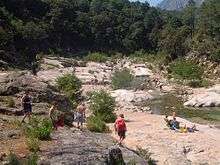Cavu
| Cavu | |
|---|---|
 Bathers along the course of the Cavu | |
| Country | France |
| Basin | |
| Main source |
1 km au north-east of Puntacci 950 m |
| River mouth |
Tyrrhenian Sea 0 m |
| Basin size | 48.9 km2 |
| Physical characteristics | |
| Length | 21.9 km |
| Discharge |
|
The Cavu or rivière de Cavu, (also called rivière de Cavo, ruisseau de Sainte-Lucie, ruisseau de Finicione) is a short river in the Corse-du-Sud department of Corsica which discharges into the Tyrrhenian Sea, and the Mediterranean Sea. In 2014 the Cavu became the first place of re-emerging schistosomiasis in Europe. As of 2016 120 people have become infected after bathing in it.
Geography
The Cavu originates at an altitude of 950 metres (3,120 ft) with what the Institut national de l'information géographique et forestière calls the creek of Sainte-Lucie, and the creek of Finicione north-east of Puntacci in the regional forest of l'Ospedale, above the community of Zonza.[1][2]
In its 21 kilometres (13 mi) course[3] it passes just south of the hamlet of Conca and of the Albarellu massif through the regional natural park of Corsica.
It generally runs from West to East. The river discharges into the Tyrrhenian Sea in Zonza, between the beach of Ovu Santu and the hamlet Olmucciu.[1] The Cavu neighbours the Solenzara to the north and the Oso to the south.[2]
Tourism
The river is popular with locals and tourists alike due to its natural beauty. People bathe in the natural pools.[4]
Sanitary issues
People who had bathed in the Cavu starting in 2011 or 2013 were found to have acquired bilharziosis, an infection with the parasite Schistosoma.[4] The French government screened exposed people and by March 2015 reported that 110 French residents acquired the urogenital form of schistosomiasis. These were the first autochthonous Schistosoma infections acquired in Europe since 1965.[5] Of 43 exposed Italian tourists, Italian scientists later found two to be infected per ELISA testing.[5] As of 2016 more than 120 local people or tourists were known to have been infected.[4] A French epidemiological study surveyed the Bulinus truncatus snails of the Cavu, which can harbor the parasite, and did not find any infected with the Schistosoma haematobium, Schistosoma bovis, and S. haematobium–S. bovis hybrids which had been isolated from people with the infection, thus making the environment an unlikely reservoir.[4]
Public Health England issued a travel warning in 2014.[6] In July 2015, the European Centre for Disease Prevention and Control declared the risk of transmission to be low.[7]
As of 2016, transmission appears to be ongoing though, as a case acquired during the summer of 2015 has been reported; The most recent and most likely hypothesis of infection is that people who became infected in the Cavu in 2013 re-seeded the river by urinating in it.[8]:3
See also
References
- 1 2 Géoportail - Institut national de l'information géographique et forestière. "Géoportail". Retrieved 19 July 2016.
- 1 2 "Rivière de Cavu". GeoNames.org. n.d. Retrieved 19 July 2016.
- ↑ "Rivière u Cavu (Y9700520)". Fiche cours d'eau. Sandre. 2 August 2012.
- 1 2 3 4 Jérôme Boissier, Sébastien Grech-Angelini, Bonnie L Webster; et al. (2016). "Outbreak of urogenital schistosomiasis in Corsica (France): an epidemiological case study". The Lancet Infectious Diseases. 16 (8): 971–979. doi:10.1016/S1473-3099(16)00175-4.
- 1 2 Beltrame A, Zammarchi L, Zuglian G, Gobbi F, Angheben A, Marchese V; et al. (October 2015). "Schistosomiasis Screening of Travelers from Italy with Possible Exposure in Corsica, France [letter]". Emerg Infect Dis. Centers for Disease Control and Prevention. Retrieved 19 July 2016.
- ↑ "Travellers to Southern Corsica warned about parasitic infection". Public Health England. gov.uk. 25 June 2014. Retrieved 19 July 2016.
- ↑ European Centre for Disease Prevention and Control Rapid Risk Assessment. Local transmission of Schistosoma haematobium in Corsica, France. First update, 23 July 2015. 23 July 2015. Accessed 19 July 2016].
- ↑ A Berry, J Fillaux, G Martin-Blondel, et al. Evidence for a permanent presence of schistosomiasis in Corsica, France, 2015. Euro Surveill, 21 (2016), PMID 26767427, DOI 10.2807/1560-7917.ES.2016.21.1.30100